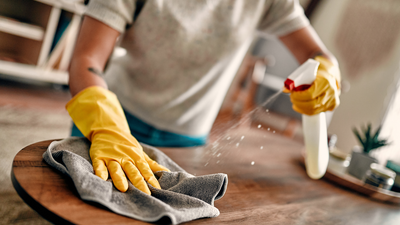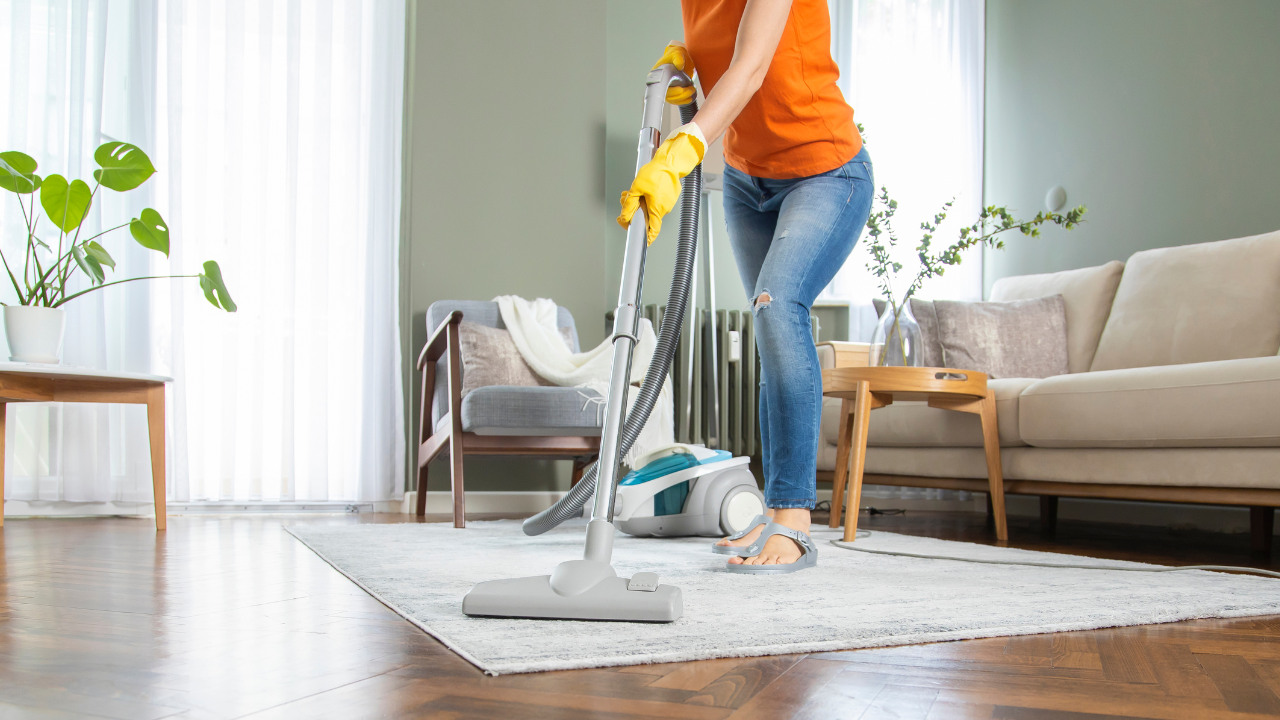Allergy alert: 10 smart cleaning tips to keep your home dust-free |

Dust is not just dirt, it’s a mix of dead skin cells, pollen, pet dander, and even microscopic insects. For those sensitive to it, even a little buildup can trigger coughing, sneezing, or watery eyes. Keeping a home dust-free isn’t about perfection; it’s about being strategic. With a few mindful cleaning techniques and smarter daily habits, a home can feel fresher, lighter, and kinder to the lungs.
Choose microfiber over regular cloths
Ordinary cotton rags only push dust around. Microfiber cloths, on the other hand, are electrostatically charged, which means they attract and trap dust particles instead of releasing them back into the air. For maximum effect, slightly dampening the cloth helps capture fine particles more efficiently.
Vacuum slowly, not just often
Speed-cleaning with a vacuum barely removes surface dust. Moving the vacuum slowly allows it to pull dust trapped deep inside carpets and rugs. Choosing a vacuum with a HEPA (High-Efficiency Particulate Air) filter makes a remarkable difference, it traps even the tiniest allergens that ordinary vacuums miss.

Wash curtains and cushions regularly
Curtains, sofas, and cushions silently collect dust over time. Opting for washable fabrics and laundering them every two to three weeks can drastically reduce dust accumulation. For non-removable upholstery, a steam cleaner works wonders, it kills dust mites and loosens embedded dirt without harsh chemicals.
Keep air purifiers running in key rooms
Air purifiers equipped with HEPA filters are a game-changer, especially in bedrooms and living areas. They continuously filter airborne particles, including dust, pollen, and pet dander. For best results, purifiers should run for several hours daily, particularly during high pollen or pollution seasons.
Declutter – Because less stuff means less dust
Every decorative item or pile of magazines becomes a dust magnet. Keeping open surfaces minimal and organized doesn’t just make a space look tidy, it reduces the number of surfaces dust can settle on. Even a small weekly decluttering ritual helps maintain long-term cleanliness.
Mind the fans and AC vents
Ceiling fans, air conditioners, and exhaust vents are often ignored during cleaning but hold significant dust buildup. Wiping fan blades with a pillowcase (to trap the falling dust inside) and cleaning AC filters every fortnight can prevent allergens from circulating around the home.
Opt for closed storage spaces
Open shelves look aesthetic but collect dust faster than closed cabinets. Storing books, clothes, or decorative items in closed compartments limits dust exposure. Transparent glass doors offer the best of both worlds, visibility and protection.
Leave shoes at the door
Shoes carry dirt, pollen, and dust from the outside world straight into the living space. Creating a “no-shoe” area near the entrance can significantly cut down on dust brought inside. Keeping washable indoor slippers for use around the house adds comfort and cleanliness.
Use natural anti-dust sprays
A simple mix of water, vinegar, and a few drops of essential oil (like eucalyptus or lavender) can create a natural dust-repelling spray. When lightly misted on wooden surfaces or blinds before wiping, it helps prevent future dust buildup while leaving a subtle fresh scent.
Don’t forget the hidden spots
Areas like behind the refrigerator, under the bed, or the tops of cupboards quietly gather dust for months. Cleaning these hidden zones once a month keeps allergens from spreading when air moves around. Using extendable dusters or vacuum attachments can make the job easier and safer for those with allergies.Disclaimer: This article provides general cleaning tips to help reduce dust and allergens in indoor spaces. It is not a substitute for medical advice. Those with severe allergies or respiratory conditions should consult a healthcare professional for personalised recommendations.
var _mfq = window._mfq || [];
_mfq.push([“setVariable”, “toi_titan”, window.location.href]);
!(function(f, b, e, v, n, t, s) {
function loadFBEvents(isFBCampaignActive) {
if (!isFBCampaignActive) {
return;
}
(function(f, b, e, v, n, t, s) {
if (f.fbq) return;
n = f.fbq = function() {
n.callMethod ? n.callMethod(…arguments) : n.queue.push(arguments);
};
if (!f._fbq) f._fbq = n;
n.push = n;
n.loaded = !0;
n.version = ‘2.0’;
n.queue = [];
t = b.createElement(e);
t.async = !0;
t.defer = !0;
t.src = v;
s = b.getElementsByTagName(e)[0];
s.parentNode.insertBefore(t, s);
})(f, b, e, ‘https://connect.facebook.net/en_US/fbevents.js’, n, t, s);
fbq(‘init’, ‘593671331875494’);
fbq(‘track’, ‘PageView’);
};
function loadGtagEvents(isGoogleCampaignActive) {
if (!isGoogleCampaignActive) {
return;
}
var id = document.getElementById(‘toi-plus-google-campaign’);
if (id) {
return;
}
(function(f, b, e, v, n, t, s) {
t = b.createElement(e);
t.async = !0;
t.defer = !0;
t.src = v;
t.id = ‘toi-plus-google-campaign’;
s = b.getElementsByTagName(e)[0];
s.parentNode.insertBefore(t, s);
})(f, b, e, ‘https://www.googletagmanager.com/gtag/js?id=AW-877820074’, n, t, s);
};
function loadSurvicateJs(allowedSurvicateSections = []){
const section = window.location.pathname.split(‘/’)[1]
const isHomePageAllowed = window.location.pathname === ‘/’ && allowedSurvicateSections.includes(‘homepage’)
const ifAllowedOnAllPages = allowedSurvicateSections && allowedSurvicateSections.includes(‘all’);
if(allowedSurvicateSections.includes(section) || isHomePageAllowed || ifAllowedOnAllPages){
(function(w) {
function setAttributes() {
var prime_user_status = window.isPrime ? ‘paid’ : ‘free’ ;
var geoLocation = window?.geoinfo?.CountryCode ? window?.geoinfo?.CountryCode : ‘IN’ ;
w._sva.setVisitorTraits({
toi_user_subscription_status : prime_user_status,
toi_user_geolocation : geoLocation
});
}
if (w._sva && w._sva.setVisitorTraits) {
setAttributes();
} else {
w.addEventListener(“SurvicateReady”, setAttributes);
}
var s = document.createElement(‘script’);
s.src=”https://survey.survicate.com/workspaces/0be6ae9845d14a7c8ff08a7a00bd9b21/web_surveys.js”;
s.async = true;
var e = document.getElementsByTagName(‘script’)[0];
e.parentNode.insertBefore(s, e);
})(window);
}
}
window.TimesApps = window.TimesApps || {};
var TimesApps = window.TimesApps;
TimesApps.toiPlusEvents = function(config) {
var isConfigAvailable = “toiplus_site_settings” in f && “isFBCampaignActive” in f.toiplus_site_settings && “isGoogleCampaignActive” in f.toiplus_site_settings;
var isPrimeUser = window.isPrime;
var isPrimeUserLayout = window.isPrimeUserLayout;
if (isConfigAvailable && !isPrimeUser) {
loadGtagEvents(f.toiplus_site_settings.isGoogleCampaignActive);
loadFBEvents(f.toiplus_site_settings.isFBCampaignActive);
loadSurvicateJs(f.toiplus_site_settings.allowedSurvicateSections);
} else {
var JarvisUrl=”https://jarvis.indiatimes.com/v1/feeds/toi_plus/site_settings/643526e21443833f0c454615?db_env=published”;
window.getFromClient(JarvisUrl, function(config){
if (config) {
const allowedSectionSuricate = (isPrimeUserLayout) ? config?.allowedSurvicatePrimeSections : config?.allowedSurvicateSections
loadGtagEvents(config?.isGoogleCampaignActive);
loadFBEvents(config?.isFBCampaignActive);
loadSurvicateJs(allowedSectionSuricate);
}
})
}
};
})(
window,
document,
‘script’,
);
Source link




